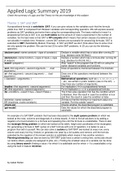Summary
Applied Logic (2ITX0) Summary 2019
- Course
- Institution
EN: This is a summary of the course Applied Logic (2ITX0) which is taught in the second quartile (Q2) at Eindhoven University of Technology. It is an elective that is mainly chosen by first-year Bachelor Computer Science and Engineering students. Applied Logic is the successor of Fundamentals of in...
[Show more]



